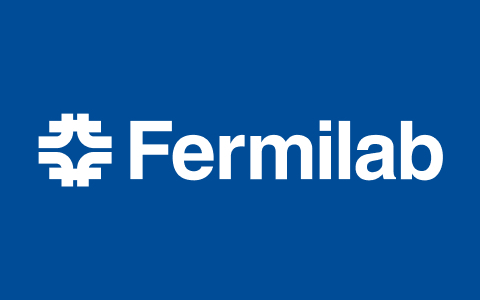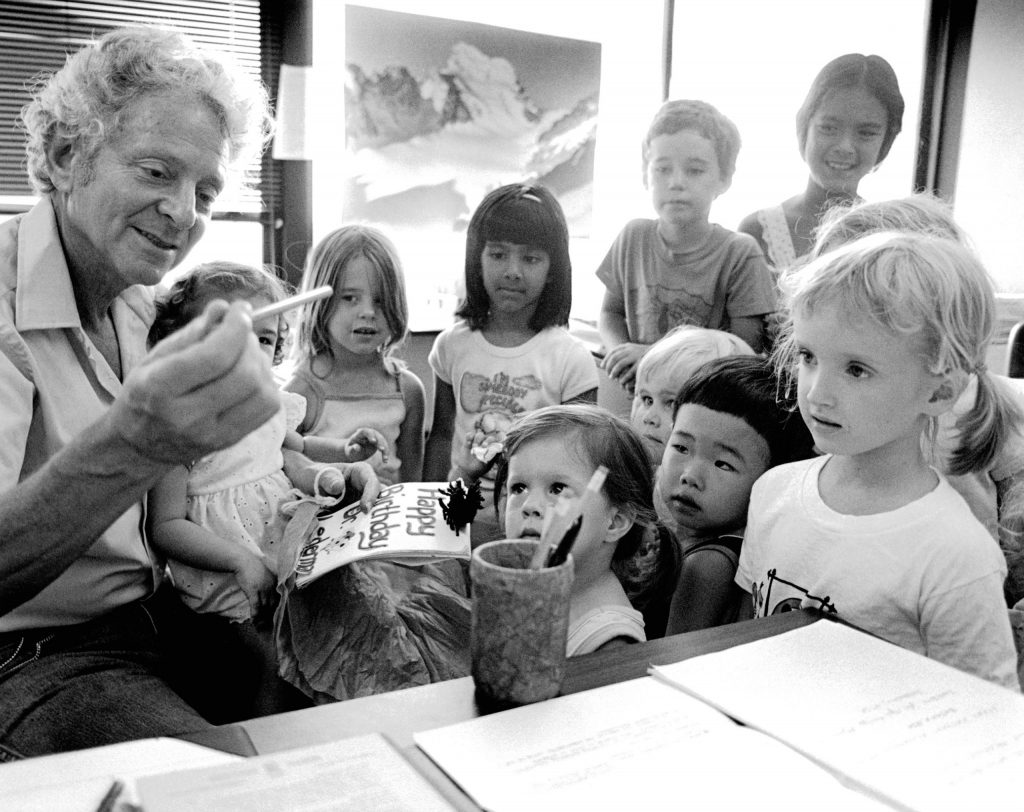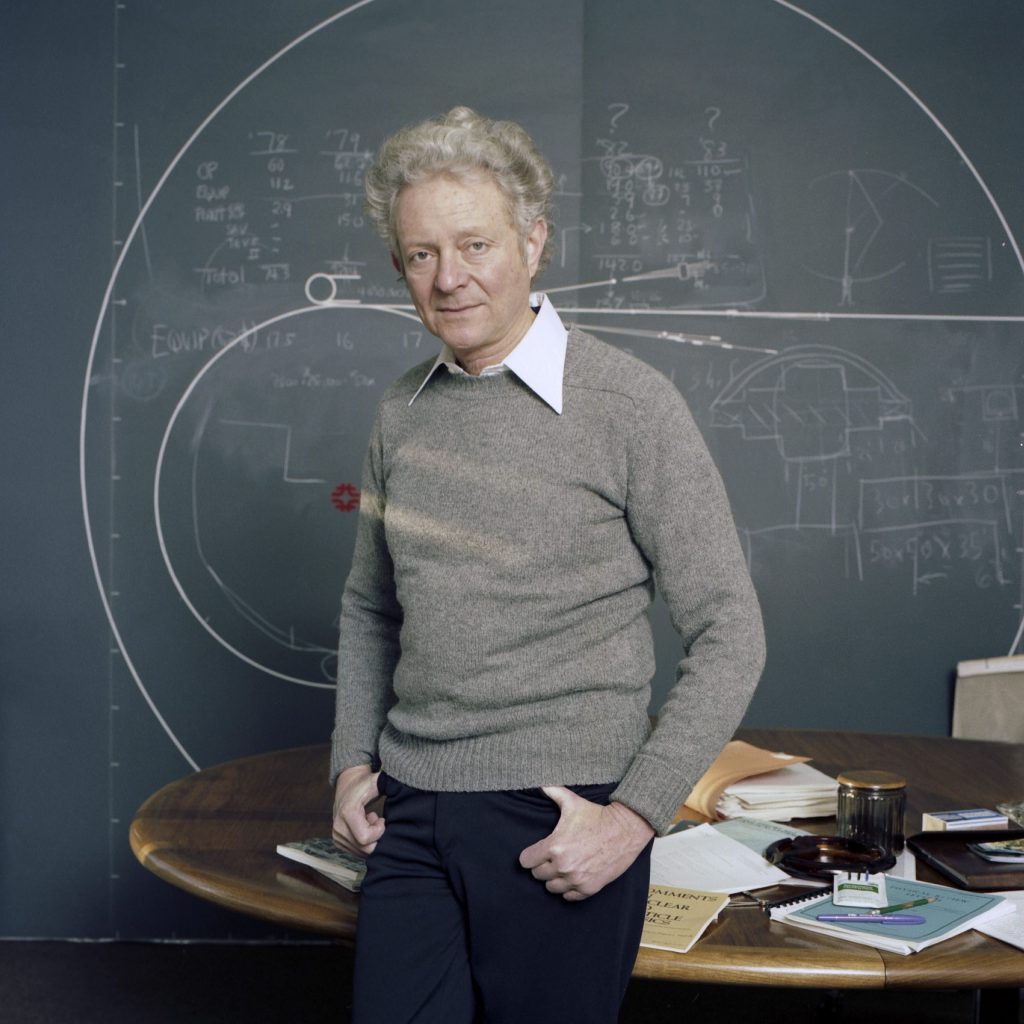Batavia, Illinois — Leon Lederman, a trailblazing researcher with a passion for science education who served as Fermilab’s director from 1979 to 1989 and won the Nobel Prize for discovery of the muon neutrino, died peacefully on Oct. 3 at a nursing home in Rexburg, Idaho. He was 96.
He is survived by his wife of 37 years, Ellen, and three children, Rena, Jesse and Rachel, from his first wife, Florence Gordon.
With a career that spanned more than 60 years, Lederman became one of the most important figures in the history of particle physics. He was responsible for several breakthrough discoveries, uncovering new particles that elevated our understanding of the fundamental universe. But perhaps his most critical achievements were his influence on the field and his efforts to improve science education.
“Leon Lederman provided the scientific vision that allowed Fermilab to remain on the cutting edge of technology for more than 40 years,” said Nigel Lockyer, the laboratory’s current director. “Leon’s leadership helped to shape the field of particle physics, designing, building and operating the Tevatron and positioning the laboratory to become a world leader in accelerator and neutrino science. Today, we continue to develop and build the next generation of particle accelerators and detectors and help to advance physics globally. Leon had an immeasurable impact on the evolution of our laboratory and our commitment to future generations of scientists, and his legacy will live on in our daily work and our outreach efforts.”
Through Lederman’s early award-winning work, he rose to prominence as a researcher and began to influence science policy. In the early 1960s, he proposed the idea for the National Accelerator Laboratory, which eventually became Fermi National Accelerator Laboratory (Fermilab). He worked with laboratory founder Robert R. Wilson to establish a community of users, credentialed individuals from around the world who could use the facilities and join experimental collaborations.
According to Fermilab scientist Alvin Tollestrup, who worked with Lederman for more than 40 years, Lederman’s success was in part due to his ability to bring people together and get them to work cohesively.
“One of his greatest skills was getting good people to work with him,” Tollestrup said. “He wasn’t selfish about his ideas. What he accomplished came about from his ability to put together a great team.”
Lederman began his tenure as Fermilab director in 1978, at a time when both the laboratory staff and the greater particle physics community were deeply divided. As a charismatic leader and a respected researcher, Lederman unified the Fermilab staff and rallied the U.S. particle physics community around the idea of building a proton-antiproton collider. Originally called the energy doubler, the particle accelerator eventually became the Tevatron, the world’s highest-energy particle collider from 1983 until 2010.
“Leon gave U.S. and world physicists a step up, a unique facility, a very high-energy collider, and his successors keep working for these things,” said Director Emeritus John Peoples, who worked with Lederman for more than 40 years and served as Lederman’s deputy director from 1988 to 1989. “Leon made that happen. He set things in motion.”
In order to begin plans for a high-energy proton-antiproton collider, Lederman convinced the greater physics community, the Department of Energy, president Reagan’s science advisor and Congress.
“Leon had the ability to lead. He was unifying and convincing,” Peoples said. “He had the ability to listen to people carefully and could synthesize things well. He was very persuasive. In some sense, I was manipulated at every level.”
Lederman’s ability to convince others stemmed in part from his charm and his sense of humor, Peoples said.
“He seemed to have an enormous storehouse of jokes,” Peoples said. “He had a lighthearted personality, he could have been a stand-up comic at times.”
Lederman was born on July 15, 1922, to Russian-Jewish immigrant parents in New York City. His father, who operated a hand laundry, revered learning. Lederman graduated from the City College of New York with a degree in chemistry in 1943, although by that point, he had become friends with a group of physicists and became interested in the topic. He served three years with the United States Army in World War II and then returned to Columbia University in New York to pursue his Ph.D. in particle physics, which he received in 1951. During graduate school, Lederman joined the Columbia physics department in constructing a 385-MeV synchrocyclotron at Nevis Lab at Irvington-on-the Hudson, New York. He remained as part of that collaboration for 28 years and eventually serving as director of Nevis labs from 1961 to 1978.
In 1956, while working as part of a Columbia team at Brookhaven National Laboratory, Lederman discovered the long-lived neutral K meson. In 1962, Lederman, along with colleagues Jack Steinberger and Melvin Schwartz, produced a beam of neutrinos using a high-energy accelerator. They discovered that sometimes, instead of producing an electron, a muon is produced, showing the existence of a new type of neutrino, the muon neutrino. That discovery eventually earned them the 1988 Nobel Prize in physics.
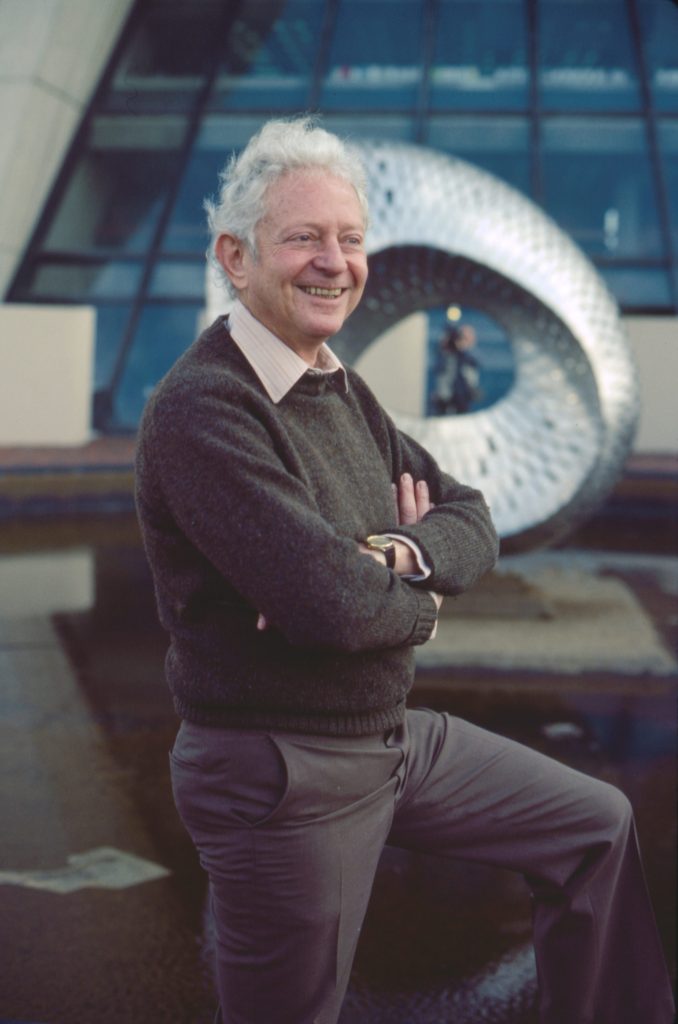
Leon Lederman stands outside Wilson Hall at Fermilab on the day he learned he was awarded the 1988 Nobel Prize.
The advancement of particle accelerators continued to spur discoveries. At Brookhaven in 1965, Lederman and his team found the first antinucleus in the form of antideuteron — an antiproton and an antineutron. In 1977, at Fermilab, Lederman led the team that discovered the bottom quark, at the time the first of a suspected new family of heavy particles.
“All of those experiments were important because they set the stage for learning that we have at least two generations of leptons and something else,” Tollestrup said.
Lederman served as director of Fermilab from 1978 to 1989. During his tenure as laboratory director, Lederman had a significant impact on laboratory culture. He was responsible for establishing new amenities that set Fermilab apart from other labs, such as the first daycare facility at a Department of Energy national laboratory and an art gallery that continues to host rotating exhibits.
He also had significant impact on the next generation of scientists. It was during his years at Columbia, an institution that required students to teach, that Lederman developed a passion for science education and outreach, which became a theme throughout his career. Between 1951 and 1978 he mentored 50 Ph.D. students. He liked to joke about their success, saying that not a single one was in jail.
As director of Fermilab, Lederman established the ongoing Saturday Morning Physics program, which has attracted students from around the Chicago areas for decades to learn more about particle physics from experts, originally from Lederman, and then a long list of leading scientists. The program has inspired generations of high school students.
Recognizing the need for more focused education in science and math, Lederman focused on creating learning spaces and opportunities for students. In the early 1980s, Lederman worked with members of the Illinois state government to start the Illinois Math and Science Academy, which was founded in 1985, and worked with officials to try to adjust the science curriculum in Chicago’s public schools so that students learned physics first, forming the foundation for their future scientific education. He founded and was chairman of the Teachers Academy for Mathematics and Science and was active in the professional development of primary school teachers in Chicago. He also helped to found the nonprofit Fermilab Friends for Science Education, a national leading organization in precollege science education.
In later years, Lederman continued his outreach efforts, often in memorable ways. In 2008, he set up shop on the corner of 34th Street and 8th Avenue in New York City and answered science questions from passersby.
During his career, Lederman received some of the highest national and international awards and honors given to scientists. These include the 1965 National Medal of Science, the 1972 Elliot Creeson Medal from the Franklin Institute, the Wolf Prize in 1982 and the Nobel Prize in 1988. He received the Enrico Fermi Award in 1992 for his career contributions to science, technology and medicine related to nuclear energy and the science and technology of energy, and was given the Vannevar Bush Award in 2012 for exceptional lifelong leaders in science and technology.
In addition to his appointments at Columbia, Nevis and Fermilab, Lederman also served as the Pritzker professor of science at Illinois Institute of Technology and chairman of the State of Illinois Governor’s Science Advisory Committee. He also served on the Board of the Chicago Museum of Science and Industry, the Secretary of Energy Advisory Board and others.
When Lederman stepped down as Fermilab’s director in 1989 and Peoples took the role, Lederman shared some sage advice. A desk nameplate, which sits on Peoples’s desk more than 25 years later, reads “I’m listening.”
Editor’s note: This article has been corrected. Lederman began his term as Fermilab director in 1979, not 1978 as was originally published.
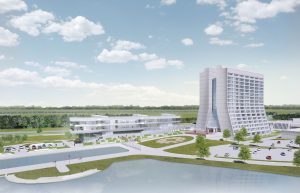
The new engineering center will be built to the east of Wilson Hall. Conceptual design by Holabird & Root
Plans to build a focal point for Fermilab engineering called the Integrated Engineering Research Center, at the Department of Energy’s Fermi National Accelerator Laboratory have been evolving for the past six years. This spring the project received the remainder of Congressional funding for design and initial construction funding. Fermilab subcontracted with an architectural firm at the beginning of July to begin transforming the building from a concept into a final design.
The new center, which many hope will be a beacon to attract some of the world’s best and brightest engineers, will be a major addition to the Fermilab site and will expand the complex of buildings surrounding Wilson Hall — a 16-story high-rise and Fermilab’s main office building that was built nearly five decades ago.
“What makes a national laboratory so valuable to the nation isn’t just the scientists,” said Tim Meyer, Fermilab chief operating officer. “It’s the combination of scientists, engineers, technicians, and facilities. This center will be a testament to that synergy. It will create a space for all to join forces and work on the future of particle physics.”
To begin the architectural design process, the project team has been communicating with engineers and scientists who will be setting up shop in the new building to determine what sort of space and facilities they will need. The goal is to design the building with an eye on adaptability. Rather than creating many custom spaces, the team is developing five or six different types of spaces that will support a variety of scientific requirements. Once space types are established, the designers and architects will turn their attention to fitting these spaces together and creating the shape and look of the building. A main requirement of the design of IERC is to respect and honor the heritage and vision of Wilson Hall and the Fermilab campus.
The new building will be located to the northeast of Wilson Hall and will connect to Wilson Hall to allow for fluid collaboration. A new parking lot will accommodate existing and future parking requirements. Construction is set to start next summer and will likely be completed by the end of 2021. A detailed schedule will be established once the project receives the final go-ahead by the Department of Energy next year.
The center will host existing and international teams of engineers, technicians, and scientists who will further develop Fermilab’s neutrino program and support Fermilab’s upgrade projects for the Large Hadron Collider at CERN. It will also provide better research and collaborative spaces for research initiatives such as liquid-argon engineering, the design of electronics and ASIC development, and quantum science programs.
“The building will consolidate and centralize people who are currently scattered across the Fermilab site to the central campus area,” said Kate Sienkiewicz, project manager for the IERC. “The idea is to connect the engineers in the IERC and the scientists and projects teams in Wilson Hall to enable collaboration in solving technical challenges. It will provide additional multifunctional space for new initiatives.”
The project, Meyer said, “indicates a level of support, confidence and enthusiasm between the Department of Energy, Congress and Fermilab, symbolizing the injection of energy and resources into the lab’s future.”
After celebrating 50 years of science and discovery last year, the Fermilab and broader particle physics communities are ready to tackle another half-century of innovation.
“Wilson Hall is iconic, it’s been here for decades and signifies all the great work that we’ve done up to this point,” Sienkiewicz said. “This new building is in some ways a physical representation of the next 50 years of Fermilab. We look forward to a bright future.”
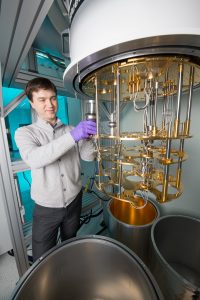
Alex Romanenko prepares to cool superconducting accelerator cavities, the silver-colored objects, to convert it into a quantum device. Photo: Reidar Hahn
Some of the most exciting advances in modern scientific research are in the field of quantum science and technology. Among them is quantum computing, a novel data-crunching technique that could revolutionize everything from biochemistry to codebreaking.
The Department of Energy’s Fermilab is positioning itself to be a forerunner in the hugely exciting field, with a new lab on site dedicated to its research and development. Favorable to Fermilab is its expertise with particle accelerator technology, which scientists are now adapting to produce game-changing quantum systems. Specifically, the superconducting radio-frequency (SRF) technology developed at the lab could help push quantum computing into a new realm.
As part of the DOE Office of Science Quantum Information Science-Enabled Discovery (QuantISED) program, a consortium of three institutions under the leadership of Fermilab scientist Alexander Romanenko has been awarded $3.9 million over two years to further SRF technology for quantum science, potentially boosting the processing speed and storage capacity of quantum devices, including quantum computers and sensors.
Beyond binary
The device you’re reading this on right now is based, at the lowest levels, on binary code – 1s and 0s. Each 1 or 0 is called a bit, and this has been the basis for all computing, right from the very first prototypes in the early 20th century. But quantum computing works differently, by exploiting strange effects that arise at the subatomic level, such that a quantum bit – or qubit – can exist as a combination of both 1 and 0.
A big stumbling block with current attempts at quantum systems is keeping this fragile superposition of 1 and 0 stable long enough to make it useful. Leading groups have managed to maintain superpositions in quantum computers for only a few milliseconds, which severely limits the potential applications of the technology. Fermilab scientists, along with collaborators at the National Institute of Standards and Technology and the University of Wisconsin – Madison, are aiming to make a big improvement on that, keeping the systems stable much longer, up to a few seconds at a time.
“The longer this stability time, the more you can do with a quantum computer. If it’s very short, you can do nothing,” said Romanenko, head of SRF technology at Fermilab. “We’re aiming to stabilize it for substantially longer than the current best. That’s the big impact we’re after.”
Home advantage
With 50 years of experience operating particle accelerators, Fermilab is home to some of the world’s leading experts in accelerating technologies, including structures called resonating cavities that use extremely low-temperature SRF technology to boost particles as they pass through them.
“Here, we really have among the best experts worldwide in different areas all together, so we are the place where integration can occur. That’s the exciting thing,” said Anna Grassellino, Fermilab scientist and deputy head of the lab’s Applied Physics and Superconducting Technology Division.
By lowering the energy of its electric and magnetic fields and operating it at near absolute zero temperatures — thousandths of a Kelvin — an accelerating cavity can be converted into a quantum device.
A special computer chip – essentially a tiny electrical circuit – is placed inside the cavity. The circuit is made of a special material that, at extremely cool temperatures, allows pairs of electrons to flow freely around — to superconduct.
The surrounding cavity gives the chip a pulse of photons, transferring a tiny amount of energy to the electrons in the chip’s circuit. But because this all takes place in the strange quantum world, the electrons become both energized and not at the same time – a superposition. Together, the chip and the cavity represent a single qubit.
A further pulse then allows the scientists to gain information from the chip.
If some of the energy of the pulse is absorbed by the cavity walls, the quantum superposition collapses, and the quantum computer becomes useless, which is one of the major problems faced by quantum groups. One of the key reasons Fermilab may be able to produce quantum systems that last longer than any other is the specialized manufacture of the cavity itself, which reduces pulse absorption and was developed at the laboratory.
“Fermilab is one of the world leaders in SRF technology,” said Fermilab Deputy Director Joe Lykken. “That’s why our research has delved into this quantum world — because we know we can make an impact based on our unique strengths in these and other areas.”
A quantum future
Quantum computers are not likely to replace current technology any time soon. The techniques are not directly comparable, and while a quantum approach is better suited for carrying out certain tasks, classical computing still maintains advantages.
“Quantum computing is different, not always better,” Romanenko explained.
The tasks that quantum computing could excel at include simulating the quantum systems that underlie high-energy physics. With its superposition advantage, a quantum computer may be able to carry out many more calculations in a given time than a classical system, rendering complex codes breakable and protein-folding far easier to model.
The quantum technology under development at Fermilab even has potential applications outside of computing. Fermilab is developing quantum sensors, such as the high-quality cavities, to detect candidate dark matter particles called dark photons.
These future possibilities may not even be too far off. The team behind the quantum effort are optimistic about the timescale.
“If all goes well, there should be the world’s best superconducting qubit here in just a few months,” Romanenko said.
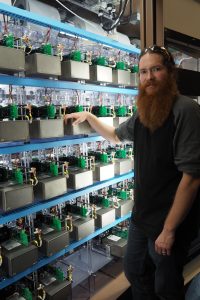
Technician Nick Gurley was one of the Fermilab team who helped install the Marx modulators for the Fermilab linear accelerator. Photo: Dan Munger
Take a walk along the hall that houses Fermilab’s linear accelerator, and you’ll see tall sets of brightly lit shelves that resemble fancy vending machines. But instead of snacks and beverages, they hold boxy structures that resemble gleaming car batteries. Arranged in neat columns and rows, these cells — known as Marx cells and installed during the last 36 months — have rejuvenated the aging Fermilab linear accelerator, or Fermilab Linac, and help guarantee its exceptional performance for the decade to come.
The installation of five new Marx modulators — each comprising 54 Marx cells — marks the conclusion of a five-year-long project to modernize critical components of the Linac. They replace equipment that had helped power accelerator components since the late 1960s.
“We needed a long-term replacement,” said Fermilab engineer Howie Pfeffer, who began designing the lab’s Marx modulator system in 2013. “We did a lot of modeling and experiments to see if the Marx structure would work. It wasn’t obvious that it would. And we determined that, yeah, we can do it. Along the way we built a number of circuits with smaller numbers of cells before committing to the full 54-cell modulators. Each circuit led us to important changes in the next.”
Most of the power that is fed to an accelerator is used to propel particles. The job of the modulator is to regulate those pulses of power — to shape them in a way that helps kick the particle beam forward at just the right time and right energies.
At Fermilab, the Marx modulators shape the pulses from a 5-million-watt amplifier, and the amplifier’s modulated power is used to accelerate protons in the Fermilab Linac. The specially formed waves propel the proton beam at a pulse rate of 15 times per second.
“The beam energy has to be exact, and most of the task of power regulation is to make sure that, as the particle beams accelerate through the Linac, they settle quickly to within one 10th of one percent of the accuracy level we want,” said Bill Pellico, leader of the Fermilab Proton Improvement Project, under which the Marx modulators were design and installed.
Capitalizing on the beam-tuning flexibility of the Marx modulators, Pfeffer and his engineering team perfectly filled the pulse prescription — a superfast, 350-microsecond pulse with a special shape specifically for injecting beam into the Linac. They also designed the modulators to make real-time corrections during the pulse, ensuring its shape would meet the accelerator’s stringent requirements. These machine learning capabilities enable the modulators to use past beam performance in improving pulse generation.
“This may be the first high-power Marx modulator with real-time pulse shaping feedback,” Pellico said.
The new modulators have improved regulation of the beam energy and also resulted in a nearly 50 percent savings in power over the older power-hungry modulators.
Marx modulators replace technology once common in analog radios and televisions — vacuum tube systems — with solid-state technology. Industry began using Marx modulators in the 1990s. Scientists, engineers and technicians have since developed a number of Marx modulators for particle accelerators, taking advantage of their efficient power use and better beam regulation.
“A lot of the old tubes in our accelerator had become obsolete. We couldn’t buy some of that stuff anymore,” Pellico said. “But now, we have not only a modern system, but also one where you can turn various cells on or off to modulate the power as desired. The design will have lots of applications in powering future particle accelerators — not just at Fermilab, but at other labs and facilities, too.”
The new, easy-to-maintain system enables the lab to generate easy-to-control particle beams, just one part of Fermilab’s effort to modernize its accelerator complex.
“Fermilab’s science program entirely depends on this working,” Pfeffer said. “It was a big responsibility. If we hadn’t gotten this work done, there’s no beam anywhere. So it feels great to see the Marx modulators completely installed and running. And thanks to our people who put it together, it’s the most beautiful circuit I’ve ever seen.”
The Proton Improvement Project is supported by the U.S. Department of Energy Office of Science.
